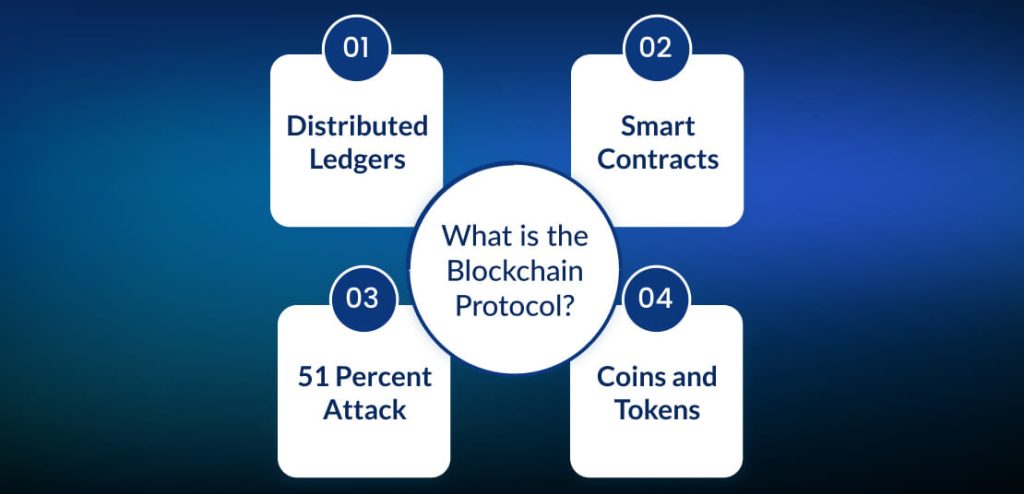When we think of cryptocurrency, several things come to mind—security, anonymity, and decentralization. One aspect that stands out among its benefits is using Blockchain protocols to protect transactions. First introduced in 2008 as an idea for decentralized operations management via a decentralized consensus system, Blockchain technology has grown substantially and become widely adopted across numerous sectors.
Numerous platforms are now incorporating blockchain technology. Blockchain is currently being utilized by various companies, from advertising agencies to banks and healthcare providers.
Nearly every business and industry is currently attempting to use blockchain technology. Blockchain is a secure digital ledger that efficiently records the transactions between two parties. There are many types of blockchains, such as private, public, and others, that have different protocols. A blockchain protocol is the rules for participants and the validated nodes within the network.
Most people with a digital background will become familiar with crypto, which is already on its way to becoming a reality. Although many of us know the names Bitcoin and Ethereum, most of us aren’t familiar with how blockchains work.
Furthermore, blockchain technology is not only used to create cryptocurrency; it also aids companies in developing solutions that are tailored to the requirements of their customers. This blog post will look at five essential blockchain-related protocols that all crypto enthusiasts should understand. Understanding the technology behind it can help you make better-informed choices.
Protocols are a key element of Blockchain technology that allows data to be seamlessly transferred across crypto networks safely and securely. Protocols are standards that outline the way data is transferred between different computer systems within the field of computing. Protocols provide safeguards to prevent malicious users from causing harm and define the format data should undergo to be accepted by the system.
Long before the World Wide Web was created, protocols were utilized in the real world. In particular, the widely used hypertext transfer protocol defines the way internet packets are structured and what information they might contain.
Blockchain protocols are similar because they allow server nodes to communicate via the Internet in a language all networks can understand.
What is a Blockchain Protocol?
Blockchain protocols are an arrangement of guidelines and rules that govern the behavior of a blockchain. They define how transactions are recorded, validated, and stored within the Blockchain. The protocol guarantees that all network users follow the same rules, creating a consensus mechanism to ensure the Blockchain’s reliability and security.
It includes elements like consensus mechanisms, decentralization, cryptographic algorithms, and constructing a permanent ledger. Blockchain technology creates a safe and transparent environment for conducting transactions and maintaining a secure database of information. The convergence of Blockchain Protocols and Java Developers India is paving the way for a future of innovative and secure applications.
Types of Blockchains

Blockchain technology has led to various decentralized and centralized platforms with advanced capabilities. It is a challenge for businesses to decide which blockchain platform will meet their needs.
The following is an in-depth review of the various types of blockchain platforms that a blockchain development company could develop and assist you in scaling your company:
Public Blockchain
It is an open-source blockchain network that enables anyone to join the consensus mechanism without being restricted by regulations or rules. Businesses connected to the Internet can easily incorporate the Internet into an active node. To join a network, it is crucial to download the program that is compatible with it. The most significant number of blockchains in use today are public blockchains.
One of the most well-known instances of the open public realm is Bitcoin. Due to the network’s public nature, it is possible to view transactions that are accessible to anyone. The specific nodes that participate within the mechanism for consensus of the Bitcoin network are awarded particular tokens to be rewarded. The other world-renowned public blockchains are Bitcoin and Ethereum. No central authority is present in a public blockchain; it’s a completely decentralized network.
While there are many benefits, there are also disadvantages. The large number of nodes could reduce the efficiency of the Blockchain as the speed of Blockchain decreases. All nodes must agree to make changes to the network, which can cause scalability issues. The consensus mechanism that is used in public blockchains is called POW (Proof-of-Work), which is a complicated issue.
Private Blockchain
The name implies that private blockchains are private blockchain networks with permissions that do not permit direct access to the Blockchain. To private Blockchain, it’s vital to Blockchains as a network member. Businesses with private blockchains don’t wish to have their information accessed by anyone and would like to protect it to a limited extent. Therefore, they prefer something more centralized, like a private blockchain.
Each entity has control over who’s included in the network. Invites to join the private Blockchain, where there are Blockchain rules or the network’s creator., must be sent out. Specific restrictions could be imposed on who is eligible to join the blockchain network.
Participants already in the Blockchain can decide who is included in this blockchain system soon. It has a central authority that is authorized to issue a permit to new members.
There are several known private blockchain networks, such as Rippe and others. These networks help increase the efficiency of transactions, as there are fewer users, meaning it takes less time to verify the transactions. Businesses should look for a custom software development company that has expertise in creating private blockchains because these blockchains can be extremely scalable, with thousands of transactions processed in a matter of seconds.
Trust issues may exist in the privately owned Blockchain to Trust to have a centralized network. Additionally, Blockchain is another disadvantage of utilizing an encrypted blockchain. Because there are fewer nodes, there is a higher chance that malicious hacks will be carried out.
Hybrid Blockchain
Hybrid Blockchain is one of the most well-known and unique blockchain networks. It has elements of both private and open blockchains. It has a smart contract that confirms new members’ participation and verifies transactions. A smart contract can access the data. There are many advantages to having a hybrid blockchain, including safeguarding participants’ privacy and permitting third-party communications.
Hybrid blockchains are a secure ecosystem in which they function to ensure they are protected from external hackers. On the other hand, scalability is a factor. Transactions take a fraction of the time and are less expensive, providing more significant and more efficient scalability than public blockchains. The reason for low-cost transactions is that there are only a few nodes to verify these transactions. The price can be reduced to 0.01 dollars per transaction.
One of the most significant advantages of hybrid blockchains is that they can be customized to provide high transparency, security, and trust. There are a variety of applications of hybrid Blockchain, including blockchain development services, supply chains, hybrid IoT banking, governments, and global trade and finance. This kind of Blockchain is believed to be the best because it offers an excellent combination of no-cost and restricted access. It is in the control of blockchain members who would like to become blockchain participants and reveal which transactions are public.
In the current business environment, companies must be able to adjust and modify at times. The best thing is that hybrid blockchains allow the possibility of changing rules. Changing the process of identifying users is impossible, but other areas can be changed. When enterprises are unsure whether to choose an open or private blockchain network, they will likely select the hybrid one.
XinFin is a well-known hybrid blockchain network explicitly designed for Ramco Systems based on Quorum and Ethereum, both an open and a private blockchain network. To create a hybrid blockchain network, you need to hire blockchain developers with public and private blockchains knowledge.
Consortium Blockchain
The Blockchain of a consortium blockchain is popular as it is a Federated blockchain. It is a type of semi-private Blockchain in which only Blockchain participants can be part of the network. There is an established system in which all participants can join and find solutions to reduce the cost of development and the time required. There are many benefits to the blockchain network, like greater flexibility, lower cost, greater control, enhanced security, and solid verification.
Diverse industries such as finance and banking, logistics, insurance, and healthcare use consortium blockchain instead of other forms of Blockchain. An Organization oversees the consortium platform, and as such, it is a permission system. However, it is different from private ones in a variety of ways.
The motivation behind the development of Blockchain was to enhance the blockchain connection between companies. It allows various organizations to collaborate and make choices to address specific work-related problems. In the end, it demonstrates the equal contributions of both organizations, and they receive the same set of credits and features.
Another benefit of the blockchain platform is the enormous amount of development and public exposure, which results in an environment of collaboration. Transactions are quite fast since it’s a permissioned network. Additionally, access is restricted, which makes transaction confirmation fast.
In a federated blockchain, your risk is 51% minimal because multiple parties ensure that participation and transactions have the proper authorization. Businesses cannot be anonymous in a consortium blockchain, lowering the chance of criminal activity on the Blockchain.

Ready to revolutionize your business? – Elevate Your Business with Our Blockchain Development Services. Reach Out Today!

Pooja Upadhyay
Director Of People Operations & Client Relations
Essential Blockchain Protocols You Need to Know
Let’s examine the five most essential blockchain protocols businesses must understand to create innovative and effective blockchain development solutions.
Hyperledger – A Flexible and Scalable Solution for Enterprise Blockchain Development
Hyperledger, an open-source project run by the Linux Foundation, has gained considerable traction in blockchain technology for enterprises. Through its modular structure, Hyperledger offers a diverse library of tools and a variety of tools to aid in developing rapid and custom blockchain-based solutions. In addition, its ability to integrate with Linux servers is a significant advantage for companies looking to take advantage of your existing systems.
- Modular design: Hyperledger Fabric offers a modular structure, allowing organizations to choose and select the necessary components to complete their projects. This flexibility will enable developers to create custom blockchain solutions not restricted to an unwieldy framework.
- Permissioned Networks: Hyperledger Fabric permits establishing a permission network, allowing only authorized users to participate in and add to the Blockchain. This type of Blockchain environment is perfect for companies that need more control over user access and data privacy.
- Plug-and-Play Components: Hyperledger Fabric offers a vast collection of pre-built components, such as intelligent contracts and consensus systems. These can easily be integrated into projects, speeding up the development process and cutting costs.
Multichain- A Private Blockchain Platform for Sensitive Data Management
Multichain is a remarkably flexible blockchain protocol that allows the creation of private blockchains suitable for companies handling sensitive information. Integrating APIs facilitates a more efficient deployment and integration with existing systems. Multichain can also be used to store and trade traditional assets like fiat currencies, which makes it an ideal choice for companies looking to incorporate Blockchain into their business.
- Cross-Chain Interoperability: Unlike other blockchain platforms, Multichain permits interoperation with blockchains. Businesses can benefit from Multichains’ private network for sensitive data while working with public blockchains to benefit the ecosystem more.
- High-throughput: Multichain is a system that prioritizes transaction speed and scalability. This makes it ideal for companies that deal with vast amounts of data or require quick processing speeds, which is crucial for micropayments or supply chain management applications.
- Multichain is Asset-neutral: Multichain allows you to control and trade with various assets, including traditional currencies, digital tokens, and physical assets by Blockchain. This allows Blockchain to investigate broader applications within its blockchain-related projects.
Enterprise Ethereum – Optimizing Blockchain for Business Applications
Ethereum is the second largest blockchain platform. The development of Enterprise Ethereum has modified it for use by enterprises. The protocol provides specific technical specifications explicitly designed for business, such as increased security and the ability to manage massive value exchanges. Furthermore, companies can create their custom versions of Ethereum using its existing codebase.
- Improved Security EE is built on Ethereum’s solid security features to provide additional privacy controls and permissions. This makes EE the ideal choice for businesses that deal with sensitive financial information and intellectual property.
- Integration with existing Ethereum Tools: Businesses that have already invested in Ethereum and the Ethereum ecosystem can benefit from the existing tools and resources for developers building projects on EE. This decreases the learning curve and speeds up the project development process.
- Private transactions: EE allows private transactions, which means that only authorized users have access to the specifics of a transaction. This feature provides security when conducting sensitive business on Blockchain.
Corda – Blockchain Technology for Finance and Banking
Created through R3, a group made up of more than 200 banks as well as banks, Corda is an open-source blockchain technology that is designed to focus on banking and finance applications. Its technological capabilities, including brilliant contract execution and data security, make it an excellent option for companies in this field. Furthermore, Corda offers customizable solutions to suit various scenarios, like trade finance and tokenization of assets.
- Concentrate on Financial Applications: Corda is specifically designed for the banking and finance sector. It includes features such as integrated legal contracts (smart contracts) and privacy features that meet the specific requirements of banks and financial institutions.
- Concentrate on Interoperability: Corda is a system that prioritizes interoperability with current financial systems. This allows companies to integrate their blockchain applications seamlessly into traditional banking infrastructures, making the smoother change.
- Compliance with Regulatory Compliance: Corda is designed with adherence to regulatory requirements in mind, making it a perfect option for businesses operating in highly restricted industries, such as finance.

Quorum is designed for an industry like the Finance Industry with Enhanced Functionality.
Quorum was created through J.P. Morgan Chase. It is a business-focused blockchain protocol with sophisticated features specifically designed for the financial industry. Its design permits greater data privacy and security, making it an ideal option for companies with sensitive financial information. Quorum also allows changes in the Ethereum codebase, like permission nodes and enhanced consensus mechanisms suited to the financial sector’s unique requirements.
- Performance Boosted: Quorum performs better than public Ethereum and offers more efficient transaction processing and capacity. This is vital for businesses that require high throughput for blockchain-related applications.
- A Permissioned Network with a Voting Quorum: This network includes a voting mechanism. It allows its members to participate in decision-making regarding governance, influencing the direction of the network’s future.
- Security Features for Privacy: Quorum provides different privacy features, such as secure transactions and consortium mode. These options allow companies to manage data visibility and protect sensitive financial data.
What is the Blockchain Protocol?

Blockchains are networks composed of several devices (nodes) connected via the Internet, all equally significant. A blockchain is a distributed ledger that registers what’s been entered and out after all the participating nodes have verified the transaction.
Protocols are crucial elements of Blockchain technology. They allow data to be exchanged safely, quickly, and safely through cryptocurrency-related networks. Protocols are rules that govern how data can be exchanged between different computer systems within the computing area.
To make the most of Blockchain technology, you must comprehend how protocols affect a network’s performance and what restrictions they may create. When learning about protocols, you should be aware of some terminology used by professionals to describe the way Blockchains communicate. These are a few terms associated with Blockchain protocol.
Distributed Ledgers:
Distributed ledgers are databases shared between several members, each managing and changing a synchronized copy of the information. Distributed ledger users can safely verify, execute, and keep track of themselves without the need for an outside party such as brokers, banks, or auditors.
Blockchains and distributed ledger technologies are peer-to-peer networks that permit many members to keep their unique versions of a shared ledger. DLTs enable members to verify, perform, and track their transactions without relying on an intermediary; instead, they need a central authority to track and transmit data to all members.
Smart Contracts:
Smart contracts are programs that execute when specific conditions are met. They are saved on a blockchain. They’re typically utilized to automate agreements, allowing all parties to be sure of the result in minutes without intermediaries or wasting time. They can also automate a process, triggering the next phase after certain conditions are satisfied.
A smart contract could have as many conditions as are required to assure the participants that the work can be accomplished promptly. The participants must agree with how the transactions and data are displayed on the Blockchain and agree with the Blockchain on “if/when…then …” rules that apply to those transactions. They must also explore every possible scenario and establish the framework to resolve disputes to determine the conditions.
51 Percent Attack:
Most cryptocurrency-distributed projects depend on anonymous network participants to reach a consensus by voting. The amount of cryptocurrency owned by each member determines their voting capacity.
Therefore, blockchain-based distributed crypto projects can theoretically be susceptible to attack by an adversary that gains control over the network by governing a majority of the coins available and utilizes that control to undermine the integrity of the network.
The 51 percent attack is unthinkable for significant projects like Ethereum or Bitcoin; however, it has occurred before on tiny coins.
Let’s understand this notion by examining an example of a 51 percent attack:
Nodes in a blockchain network are expected to broadcast the blocks they generate to the remainder of the network. If a particular node or group of nodes acquires control of more than 50 percent of the network, it can create blocks in private instead of broadcasting them out to the other nodes in the network.
The network will continue to utilize the public Blockchain, and nodes can double-spend, spending first on the public Blockchain on their private Blockchain. They can then use their private Blockchain and build long blocks, as they are the majority in the overall network.
The other participants will think this is the proper chain due to the rule of the longest chain, which considers the longest chain the most legal to mine. Any transactions that were previously not part of the chain (because they were not public) are reversed, allowing malicious nodes to access other individuals’ funds.
Coins and Tokens:
To ensure that the network is running, each blockchain protocol needs the use of a digital asset. They are also used to motivate participants in the network to take part. This requires the use of digital assets, such as tokens and coins.
Coins and tokens are digital assets that permit blockchain networks to operate. Their purposes have been, for the vast majority, identical. The only difference between their protocols is the level at which they are defined.
- Coins:
This protocol defines the concept of coins on the most basic level. The blockchain network’s primary digital asset is the coin, and its primary currency is Bitcoin.
- Tokens:
Tokens are digital currencies defined at a higher level through smart contracts rather than the protocol. The Ethereum protocol, for instance, has its local currency, Ether.
Ethereum’s protocol lets developers develop decentralized applications (dApps), among other things. One dApp’s node-communication rules could differ from another dApp’s contract-defined rules for node communication. Therefore, dApps are ‘native digital assets,’ which are tokens.
Conclusion
The selection of the Blockchain protocol is among the most important decisions to make when launching a Blockchain software development. Protocols are essential as they restrict the capabilities that your application can provide.
It is essential to remember that the most well-known protocols utilize highly advanced technology that requires the involvement of thousands of computing scientists. Using a protocol rather than creating a new one will enable you to finish your task quickly and use fewer resources.

Harness the Future of Technology with Our Blockchain Development Solutions.

Pooja Upadhyay
Director Of People Operations & Client Relations

